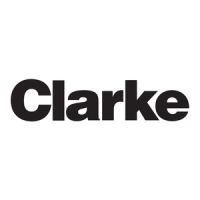36
greatly reduce the cooling systems efficiency and
protection capabilities.
Recommended supplemental coolant inhibitors are a
combination of chemical compounds which provide
corrosion protection, cavitation suppression, pH
controls and prevents scale. These inhibitors are
available in various forms, such as liquid packages or
integral parts of an extended life coolant.
It is imperative that inhibitors are used in all Caterpillar
engine cooling systems. A pre-charge dosage must be
used at the initial fill with a conventional coolant, that
is not fully formulated, and the maintenance dosage
must be added at each service interval. Conventional
coolants must meet ASTM D4985 or ASTM D6210 to
be used in Cat engines. Conventional coolants rely on
inorganic inhibitors and are (re)charged with a
Supplemental Coolant Additive (SCA)
An extended life coolant that meets ASTM D4985 or
ASTM D6210 and contains less than 125 ppm of
silicon (present as silicate) can be used in Cat engines
to the recommended maximum service life. Extended
life coolants rely on organic inhibitors and are
recharged with an Extender. Extenders are typically
added at one half the service life of the coolant.
Inhibitors become depleted through normal
operation; additional inhibitors must be added to
the coolant as required to maintain original
strength levels.
To properly check inhibitor concentration, it may be
necessary to contact your local Service/Dealer for
assistance. Refer to Parts Information Section to
obtain the part number for the factory Coolant Analysis
Kit. This kit can be purchased for a nominal fee for
analyzing the conditions of the engine’s coolant.
3.4.6 Procedure for Filling Engine
During filling of the cooling system, air pockets may
form. The system must be purged of air prior to being
put in service. This is best accomplished by filling
with a pre-mix solution. Refer to Figure #18 for proper
fill level.
Caution: Do not overfill cooling system. A
pressurized system needs space for heat
expansion without overflowing.
Install the pressure cap, start and run engine for
approximately 5 minutes to purge the air from the
engine cavities.
When verifying that the coolant is at a safe operating
level, it is best to wait until the engine temperature
drops to approximately 120ºF (49ºC), or lower, before
removing the pressure cap.
Remove the pressure cap and refill to the proper fill
level. To continue the de-aeration process, start and
run engine until the temperature stabilizes at
approximately 160°-200° (71°-93° C) or run engine for
25 minutes, whichever is longer. During this warming
process, you may see coolant coming from the
overflow tube attached at the pressure cap location.
Allow engine to cool, then remove the pressure cap
and refill to the proper fill level.
Caution: Do not remove pressure cap while coolant is
at normal operating temperatures. Possible personal
injury could result from the expulsion of hot coolant.
Figure #18
3.4.7 Providing Adequate Raw Water Supply to the
Engine Heat Exchanger
3.4.7.1 Raw Water Supply
Most Clarke diesel engine fire pump drivers are heat
exchanger cooled and some engines also have a charge
air cooler (CAC) that uses raw water to cool the air
before entering the intake manifold. If you have a
radiator cooled Clarke engine, you can disregard this
section. Heat exchanger cooled diesel engine drivers
require a clean source of pressurized water from the
discharge side of the fire pump. To prevent
overheating, the loop must provide a specified
minimum amount of raw water flow.

